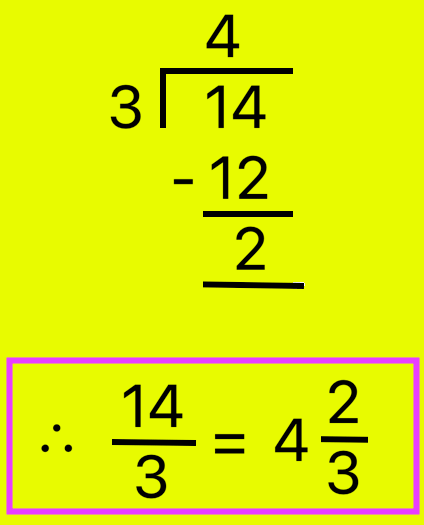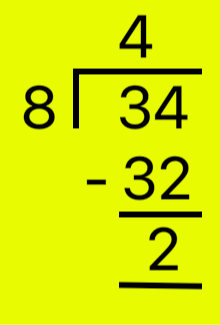Subscribe to our ▶️ YouTube channel 🔴 for the latest videos, updates, and tips.
Changing Fractions
In changing fractions we will discuss how to change fractions from improper fraction to a whole or mixed number, from mixed number to an improper fraction, from whole number into an improper fraction.
Changing an improper fraction to a whole number or mixed number:
Here we will learn about changing an improper fraction to a whole or mixed number.
Cut out three circle of the same size.
Fold each circle in four.
Shade 4 parts from the first circle, 4 parts from the second circle and one part from the third circle.
Total parts shaded = 9 we have 9/4 parts.
Total parts in each circle 4 which is really 21/4 parts.Note:
When the numerator of a
fraction is greater than the denominator, the fraction is greater than
1. This can be written as mixed number.
Changing improper fractions to mixed numbers by dividing the numerator with the denominator.
1. 9/4
= 21/4
Therefore, 9/4 = 21/4
2. 24/10 Try to reduce the numerator and denominator by a common denominator.
24/10 ÷ 2/2 = 12/5
Now divide numerator by denominator.
= 22/5
|
Improper fraction 24/10 |
Mixed number |
Sometimes an improper fraction change into a whole number when there is no remainder.
Conversion of an Improper Fraction into a Mixed Number:
3. Convert \(\frac{14}{3}\) into a mixed number.
First Method:
|
Steps I: Divide the numerator by the denominator. Step II: Write the value as Q\(\frac{R}{D}\) Q = Quotient = 4 R = Remainder = 2 D = Divisor = 3 |
Therefore, \(\frac{14}{3}\) = 4\(\frac{2}{3}\)
Second Method:
\(\frac{14}{3}\) = \(\frac{12}{3}\) + \(\frac{2}{3}\)
= 4 + \(\frac{2}{3}\)
= 4\(\frac{2}{3}\)
4. Convert \(\frac{34}{8}\) into a mixed number.
|
First Method: \(\frac{34}{8}\) = 4\(\frac{2}{8}\) = 4\(\frac{1}{4}\), [ Second Method: \(\frac{34}{8}\) = \(\frac{32}{8}\) + \(\frac{2}{8}\) = 4 + \(\frac{2}{8}\) = 4\(\frac{2}{8}\) = 4\(\frac{1}{4}\) Therefore, \(\frac{34}{8}\) = 4\(\frac{1}{4}\) |
5. \(\frac{16}{2}\) ÷ \(\frac{2}{2}\) = \(\frac{8}{1}\) = 8
Note:
When the denominator is 1 in an improper fraction, it becomes a whole number.
Changing a Mixed Number to an Improper Fraction:
Mother said I had eaten 31/2 chocolates.This is what I took : 1/2 + 1/2 + 1/2 + 1/2 + 1/2 + 1/2 + 1/2 = 7 halves
= 7/2
But I looked carefully. I had eaten 3 full + 1/2 chocolate.
Let us learn the mathematical way of changing mixed numbers to improper fractions.
Mixed numbers = Denominator × Whole numbers + Numerator
5\(\frac{1}{2}\) = 2 × 5 + 1 = \(\frac{11}{2}\)
Multiply denominator and whole number 5.
2 × 5 = 10
|
Mixed numbers 5\(\frac{11}{2}\) |
Improper fraction \(\frac{11}{2}\) |
Add the numerator 10 + 1 = 11
This becomes the new numerator.
The old denominator remains.
Conversion of a Mixed Number to an Improper Fraction:
1. Convert 7\(\frac{2}{8}\) into an improper fraction.
First Method:
7\(\frac{2}{8}\) = \(\frac{(7 × 8) + 2}{8}\)
= \(\frac{56 + 2}{8}\)
= \(\frac{58}{8}\)
Second Method:
7\(\frac{2}{8}\) = 7 + \(\frac{2}{8}\)
= \(\frac{7}{1}\) + \(\frac{2}{8}\)
L.C.M. of 1 and 8 is 8.
\(\frac{7 × 8}{1 × 8}\) + \(\frac{2}{8}\) = \(\frac{56}{8}\) + \(\frac{2}{8}\)
= \(\frac{56 + 2}{8}\)
= \(\frac{58}{8}\)
2. Convert 5\(\frac{1}{6}\) into an improper fraction.
First Method:
5\(\frac{1}{6}\) = \(\frac{(5 × 6) + 1}{6}\)
= \(\frac{30 + 1}{6}\)
= \(\frac{31}{6}\)
Second Method:
5\(\frac{1}{6}\) = 5 + \(\frac{1}{6}\)
= \(\frac{5}{1}\) + \(\frac{1}{6}\)
M.C.M. of 1 and 6 is 6.
\(\frac{5 × 6}{1 × 6}\) + \(\frac{1}{6}\) = \(\frac{30}{6}\) + \(\frac{1}{6}\)
= \(\frac{30 + 1}{6}\)
= \(\frac{31}{6}\)
Changing a whole number into an improper fraction:
|
Whole number 7 |
Improper fraction 7/1 |
Since the denominator shows total parts and anything whole is out of 1
part, the improper fraction is formed by using 1 as the denominator.
Questions and Answers on Changing Fractions:
1. Convert the given fractions to mixed fractions:
(i) \(\frac{11}{2}\)
(ii) \(\frac{15}{9}\)
(iii) \(\frac{25}{4}\)
(iv) \(\frac{57}{7}\)
Answers:
1. (i) 5\(\frac{1}{2}\)
(ii) 1\(\frac{6}{9}\)
(iii) 6\(\frac{1}{4}\)
(iv) 8\(\frac{1}{7}\)
2. Convert the given mixed fractions to improper fractions:
(i) 3\(\frac{5}{6}\)
(ii) 7\(\frac{2}{9}\)
(iii) 5\(\frac{3}{4}\)
(iv) 8\(\frac{2}{3}\)
Answers:
2. (i) \(\frac{23}{6}\)
(ii) \(\frac{65}{9}\)
(iii) \(\frac{23}{4}\)
(iv) \(\frac{26}{3}\)
3. Change the following mixed fractions into improper fractions:
(i) 5\(\frac{4}{7}\)
(ii) 3\(\frac{3}{4}\)
(iii) 2\(\frac{5}{9}\)
(iv) 6\(\frac{1}{8}\)
(v) 4\(\frac{2}{9}\)
Answer:
3. (i) \(\frac{39}{7}\)
(ii) \(\frac{15}{4}\)
(iii) \(\frac{23}{9}\)
(iv) \(\frac{49}{8}\)
(v) \(\frac{38}{9}\)
4. Change into a whole number or a mixed numeral:
(i) \(\frac{40}{8}\)
(ii) \(\frac{13}{5}\)
(iii) \(\frac{15}{12}\)
(iv) \(\frac{16}{8}\)
(v) \(\frac{25}{9}\)
Answer:
4. (i) 5
(ii) 2\(\frac{3}{5}\)
(iii) 1\(\frac{1}{4}\)
(iv) 2
(v) 2\(\frac{7}{9}\)
Related Concept
- Fraction of a Whole Numbers
- Representation of a Fraction
- Equivalent Fractions
- Properties of Equivalent Fractions
- Like and Unlike Fractions
- Comparison of Like Fractions
- Comparison of Fractions having the same Numerator
- Types of Fractions
- Changing Fractions
- Conversion of Fractions into Fractions having Same Denominator
- Conversion of a Fraction into its Smallest and Simplest Form
- Addition of Fractions having the Same Denominator
- Subtraction of Fractions having the Same Denominator
- Addition and Subtraction of Fractions on the Fraction Number Line
From Changing Fractions to HOME PAGE
Didn't find what you were looking for? Or want to know more information about Math Only Math. Use this Google Search to find what you need.






New! Comments
Have your say about what you just read! Leave me a comment in the box below. Ask a Question or Answer a Question.